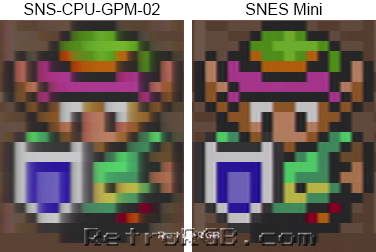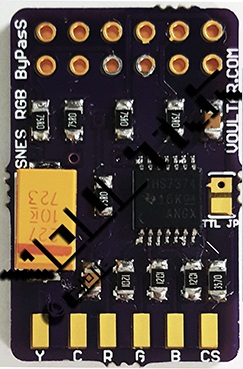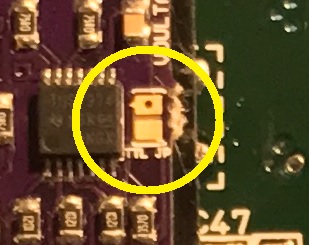SNES:SNES Jr Pre-Assembled THS7374 Amp: Difference between revisions
No edit summary |
No edit summary |
||
| Line 49: | Line 49: | ||
If your amp board supports S-Video as well, you'll need to solder two more wires to the board. | If your amp board supports S-Video as well, you'll need to solder two more wires to the board. | ||
#Start by removing the screw that attaches the voltage regulator to the heatsink, then remove the two screws on the bottom of the motherboard that are holding the heatsink in place. | #Start by removing the screw that attaches the voltage regulator to the heatsink, then remove the two screws on the bottom of the motherboard that are holding the heatsink in place. [[File:SNESMiniHeatsinkScrews.jpg]] | ||
[[File:SNESMiniHeatsinkScrews.jpg]] | #Then, find the S-RGB chip that's right next to the cartridge port and solder one wire to luma and the other to chroma [[File:SNESs-rgbY-C.jpg]] | ||
#Then, find the S-RGB chip that's right next to the cartridge port and solder one wire to luma and the other to chroma | #I like to add a small amount of heatshrink tubing to the wires, then bolt the heatsink on over it. Please note: The wires are NOT being pinched by the heatsink! There is space between the heatsink and motherboard and the two Y&C wires fit nicely underneath: [[File:SNESs-rgbYCwiresrun.jpg]] | ||
#I like to add a small amount of heatshrink tubing to the wires, then bolt the heatsink on over it. Please note: The wires are NOT being pinched by the heatsink! There is space between the heatsink and motherboard and the two Y&C wires fit nicely underneath: | #Lastly, run the Y/C wires through the hole in the bottom of the motherboard (as shown on the right below) and solder them to the board: [[File:SNESMiniTHS7374FullInstallation.jpg]] | ||
[[File:SNESs-rgbYCwiresrun.jpg]] | |||
#Lastly, run the Y/C wires through the hole in the bottom of the motherboard (as shown on the right below) and solder them to the board: | |||
[[File:SNESMiniTHS7374FullInstallation.jpg]] | |||
Finished | Finished | ||
This is a great mod for the SNES Mini. The THS7374 chip is extremely sharp and the video output looks amazing. Check out the difference from an average (non-1CHIP) SNES 1 to a SNES Mini: [[File:SNS-CPU-GPM-02vsSNESMini.png]] | This is a great mod for the SNES Mini. The THS7374 chip is extremely sharp and the video output looks amazing. Check out the difference from an average (non-1CHIP) SNES 1 to a SNES Mini: [[File:SNS-CPU-GPM-02vsSNESMini.png]] | ||
Revision as of 03:26, 13 June 2022
Mitch1256
This page shows how to use a pre-made RGB Amp to bypass the SNES Mini's internal encoder and enable RGB (and depending on the board) S-Video as well. The amp you purchase may not look exactly like the one pictured, however the installation will be the same for all unless otherwise noted.
Warning: Make sure this is the right guide for your amp!!!
Amp Board: You'll need one of the following boards to perform this mod:
Voultar's THS7374 SNES Amp with S-Video support
Tools / Parts Needed:
You'll need a few tools for this mod: Pre-Made amp linked above Basic soldering skills. SNES RGB cable The 4.5mm tool that opens the SNES Philips head screwdriver Soldering iron / solder Thin gauge wire Flux or flux pen (not required, but strongly recommended) Heatshrink tubing (not required, but recommended)
RGB Mod:
- Open the console and remove the board (pretty much just unscrew everything):
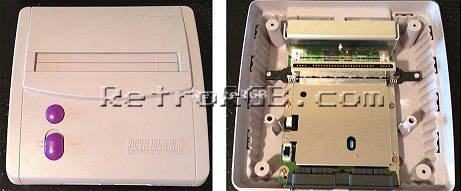
- Some SNES Mini's come from the factory with the two ground pins soldered together. If your system has this, you could either cut the solder in the middle (be really careful not to damage the pins), or use a solder-removing method (de-soldering iron, solder wick, etc). Also, you'll most likely see some capacitor ends sticking out and interfering with the area you'll be mounting the board in. Just snip all 4:
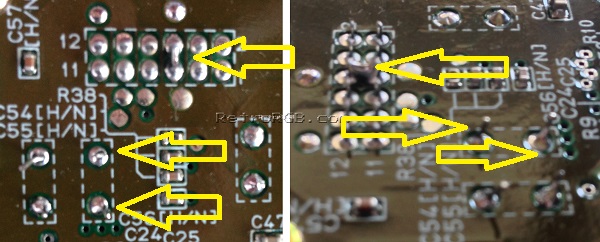
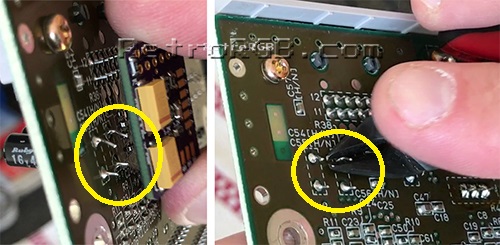
- Next, prepare the pre-made amp board. The bottom of the amp board has no components on it, however it's better to add a piece of non-conductive tape to the bottom to be safe:
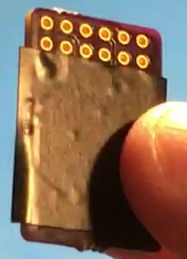
- Now slide the amp over all the multi-out pins. Then carefully solder each pin, making sure not to let the solder spill over onto another pin (flux helps, but isn't required). Then add solder to all six pads on the bottom (the picture shown is pre-solder):
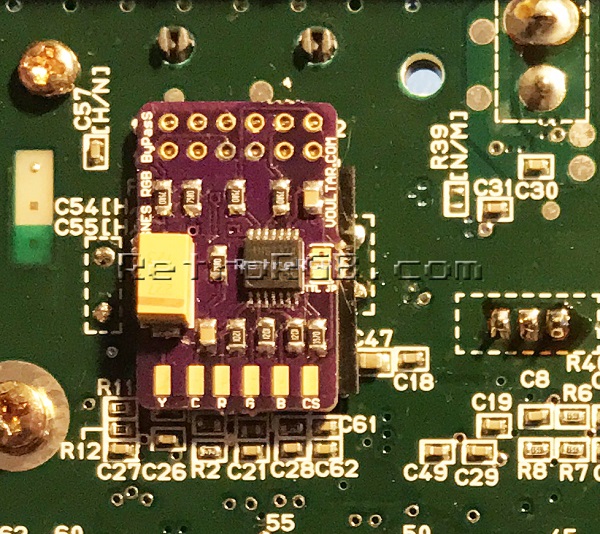
- Next, locate the following spot on the motherboard:
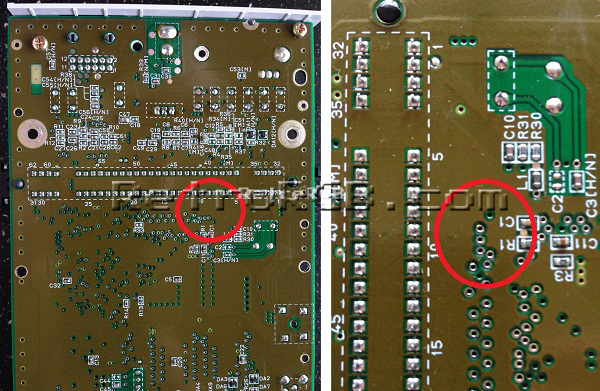
- Solder thin wire to the following "via" holes to get RGBs. It's recommended using flux on these via's!!! Make sure the stripped wire isn't too long, as it will stick out the top of the motherboard:

- Cut the wires to length and solder them to the corresponding RGBs pads on the amp, and add a bit of heat shrink tubing. Your installation should now look like this:

If your board only supports RGB, or if you don't plan on using S-Video, that's it!
TTL Sync Jumper (Voultar's board only)
If you purchased Voultar's board, you'll notice a jumper labeled "TTL" on it. That jumper will set the sync type. Here's both the full explanation and the "layman's" explanation:
Voultar's Explanation: The C-Sync cable that you purchase may or may not have a load resistor on the C-Sync line to attenuate the amplitude making it 75 ohm compatible. My board integrates the attenuation, so only a C-Sync cable that is pass-thru is required. If however, your cable attenuates TTL C-Sync to 75Ohm, or you require a TTL sync level for your device, short the TTL JPR on the board. Shorting the TTL jumper will restore the C-Sync signal back to a TTL logic level.
An easy way to figure it out: Use a multimeter to check the sync line on your cable and it's very easy to do this with the board still out: Simply plug in your cable and check between pin 3 on the multi-out and pin 20 on your SCART head. If you get a beep, you're good. If you get resistance, short the jumper.
S-Video Installation
If your amp board supports S-Video as well, you'll need to solder two more wires to the board.
- Start by removing the screw that attaches the voltage regulator to the heatsink, then remove the two screws on the bottom of the motherboard that are holding the heatsink in place.
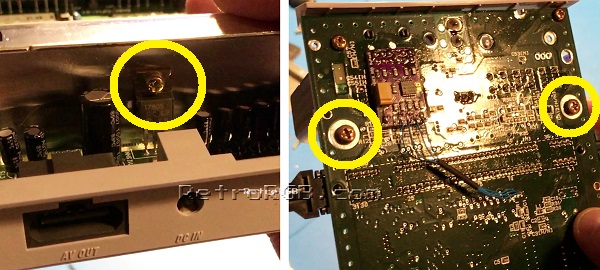
- Then, find the S-RGB chip that's right next to the cartridge port and solder one wire to luma and the other to chroma
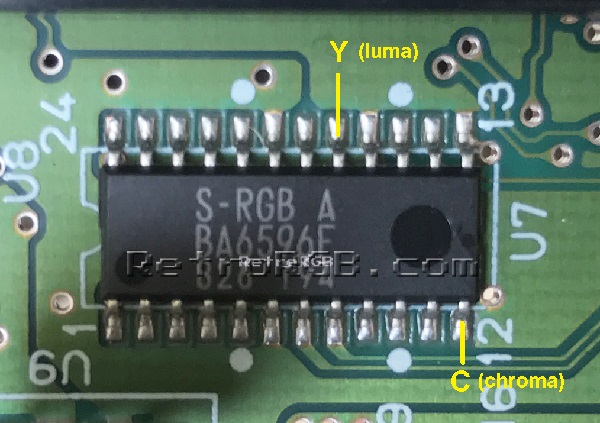
- I like to add a small amount of heatshrink tubing to the wires, then bolt the heatsink on over it. Please note: The wires are NOT being pinched by the heatsink! There is space between the heatsink and motherboard and the two Y&C wires fit nicely underneath:
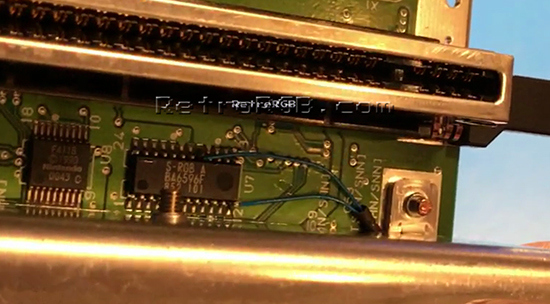
- Lastly, run the Y/C wires through the hole in the bottom of the motherboard (as shown on the right below) and solder them to the board:
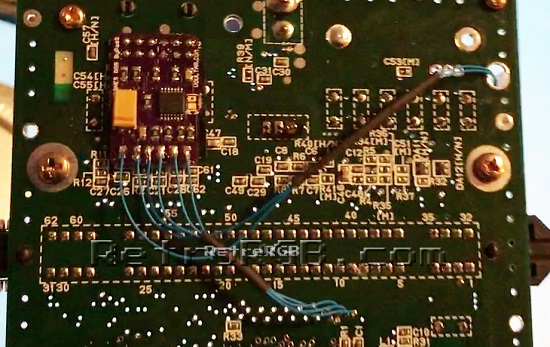
Finished
This is a great mod for the SNES Mini. The THS7374 chip is extremely sharp and the video output looks amazing. Check out the difference from an average (non-1CHIP) SNES 1 to a SNES Mini: 